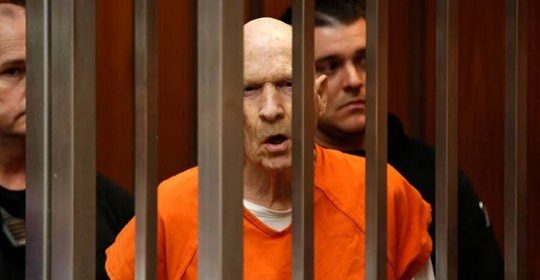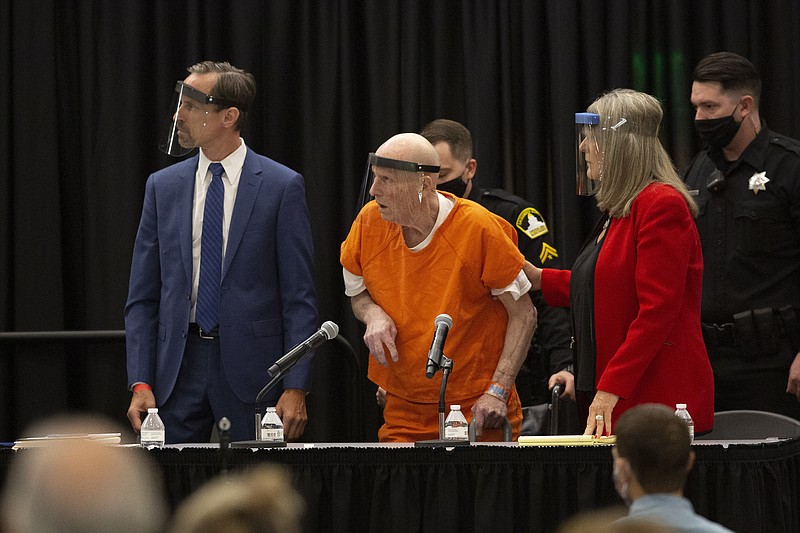Golden State Killer Suspect Pleads Guilty To More Than A Dozen Murders

Golden State Killer Suspect Pleads Guilty To More Than A Dozen Murders
It took decades to identify the Golden State Killer, with only DNA evidence and genealogy services solving the mystery. After two years behind bars, Joseph James DeAngelo has pleaded guilty.
The Golden State Killer, who in the 1970s and 1980s terrorized California, pleaded guilty to 13 first-degree murder counts on Monday. Although Joseph James DeAngelo, a 74-year-old suspect, has raped 50 women during his spree, State statutes limiting those crimes have allowed him to avoid rape charges.

The New York Times reported that in April 2018, the former police officer was arrested. For decades, authorities have failed to identify him, believing the different people to be Visalia Ransacker, East Area Rapist and Original Night Stalker. The tides were only turned by DNA evidence and genealogy services.
The elderly serial murderer and rapist, after two years in prison, admitted to his crimes. While it took almost half a century to catch him, the hours-long hearing in front of victims’ families and district attorneys saw his guilty pleas garner him 11 life consecutive sentences.
Covered in an orange jumpsuit and a plastic face shield to ward against COVID-19, DeAngelo is no longer the spry man who vaulted fences and snuck into women’s homes. The hearing held inside a Sacramento State University ballroom, meanwhile, was live-streamed because of the pandemic.
Sacramento County deputy district attorney Amy Holliday announced DeAngelo’s plea arrangement in front of survivors and the families of his victims. The deal removed the possibility of the death penalty, in exchange for DeAngelo’s guilty pleas, which will see him behind bars for the rest of his life.
On top of that, the agreement saw DeAngelo admit to numerous crimes that he wasn’t charged for. Many of the rapes he committed weren’t able to be prosecuted due to statute of limitations issues. When asked if he understood the terms of his sentencing, the old man replied with a mere “yes.”
As for the plea deal decision in lieu of a jury trial, Holliday explained the choice at the very beginning of the hearing. Though it was initially slotted for May, “it had to be postponed because of court closures and the dangers of bringing elderly or high-risk individuals into the courtroom.”
“Many of the victims, witnesses and law enforcement are in their 80s and 90s,” she added. “Many of these people all deeply affected by these crimes may not be with us at the time of jury trial.”

For the families attending the event in person, justice and relief were felt. For decades, DeAngelo had committed his gruesome crimes as he pleased — from California’s southern coast and the Central Valley to the Bay Area and neighbourhoods of Sacramento — and he had seemed untraceable and unstoppable.
“The fear in the community was like something I had never seen before,” said Carol Daly, former Sacramento sheriff’s detective. “People were afraid wherever they went.”
By the 1990s, it seemed as though he’d vanished — though he taunted one of his victims in 2001 by giving her a phone call to ask if she remembered, “when we played.” That same year, DNA evidence began to link the East Area Rapist and Original Night Stalker cases to one singular person.
Late true crime author Michelle McNamara took it upon herself to piece the decades-long puzzle together. Her efforts reinvigorated cold-case investigator Paul Holes’ urge to find the man. As chronicled in HBO’s documentary series I’ll Be Gone In the Dark — their collaboration finally did.
McNamara had always wagered that it would be this new method of solving crimes that would finally identify the man she had coined as the Golden State Killer. Her optimism renewed that of Holes, who cathartically tracked DeAngelo down in 2018.
Opting not to knock on DeAngelo’s door and confirm or clear him as a suspect beforehand instead, he surreptitiously retrieved some of his DNA from a car door handle and discarded tissue to confirm he was their man. Holes was mere weeks from retirement when he made the career-making bust.
Now, while many of the victims and their families are grateful justice has finally been served at the Golden State Killer trial, some are frustrated that California Governor Gavin Newson’s moratorium on the death penalty has allowed DeAngelo to keep his life. Others, meanwhile, have mixed feelings about the privacy issues breached to catch him.
“The resolution of the Golden State Killer case should be lauded for bringing closure to these investigations, but the means by which DeAngelo was identified remains troubling,” said Elizabeth Joh, law professor at the University of California, Davis.
District Attorney Anne Marie Schubert of Sacramento County, meanwhile, always encouraged the role of genetic genealogy and surreptitiously obtained DNA evidence.
Meanwhile, prosecutors are still unsure as to why the man Schubert called the “real-life version of Hannibal Lecter” suddenly stopped committing crimes. The killer ceased when he was in his 40s, and DeAngelo worked at a Save Mart grocery store and lived a traditional suburban life in Sacramento.
The fact that he walked among regular citizens, even victims such as Gay Hardwick — who was raped in 1978 as her husband Bob was helplessly tied up — is deeply unsettling. However, Hardwick now says she finally feels a sense of peace.
“I already feel relieved,” she said. “He’s going away and never coming out and there won’t be any appeals. He will die in prison.”